The background
As Nazi forces broke through the defence lines and overran Split, on 25th September 1943 a small group of people set off for Italy on a bracera (a traditional Croatian sailing boat with an engine, also sometimes called a trabakul) from Slatine on the island of Čiovo just off Trogir. Trogir is an ancient city not far from Split. The modern-day Split airport is situated just outside Trogir.
The distance from Split to Bari is 267.04 kilometres (165.93 miles, 144.1 nautical miles). A modern aeroplane travelling at an average speed of 560 miles per hour would arrive in about 20 minutes. http://www.distancefromto.net/between/Split/Bari
Čiovo to Bari is 269 km as the crow flies. The journey in a modern motorized boat comparable in size to the bracera, travelling at roughly 8 knots, would take some 20 hours in ideal conditions without stopping. The bracera of 1943 would have had a less powerful engine, and also used sails where possible. The escape spanned just over a week, due to weather conditions and the need for detours and subterfuge.
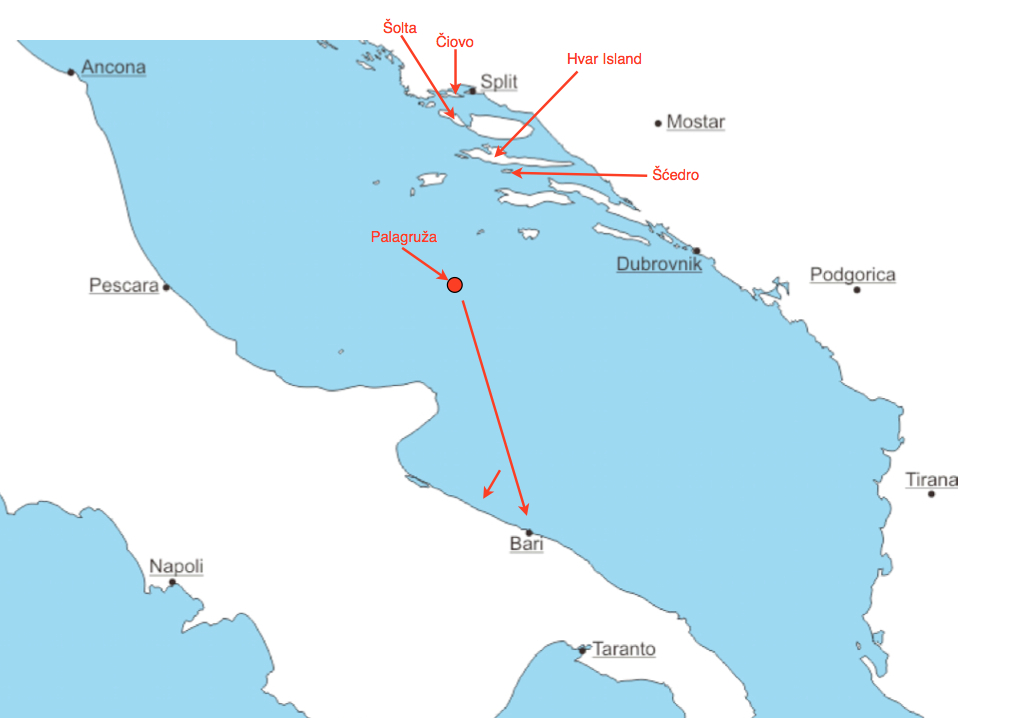
The context
Italy and Croatia. In the early part of the Second World War, then-Yugoslavia came under Axis occupation, in several parts. Serbia was ruled by the German-appointed Milan Nedić. Croatia was governed by Ante Pavelić, the Ustaša quisling leader of the ‘Independent Croatian State’ (Nezavisna država hrvatska) created by the German Nazis when they invaded Yugoslavia in April 1941. Dalmatia was ruled briefly by the Ustaše, but came under the governorship of the Kingdom of Italy following the signing of the Rome Accords on May 18th 1941, in which Pavelić ceded most of Dalmatia to the Italians. Italy was allied with Nazi Germany at the time, having signed the ‘Pact of Steel’ on May 22nd 1939.
Dalmatia Under Occupation
The situation in occupied Dalmatia was complicated because of the different factions, who were often engaged in making war on each other, as well as, or in some cases instead of fighting against the occupying forces. The main groupings were the Partisans (Partisan National Liberation Army of Yugoslavia, NOVJ), the Ustaše (Croatian nationalists) and Četniks (Serb nationalists), all of whom were vying for supremacy over the others. There were also people who were not militarily involved in the internal power struggle, but were prepared to fight against the occupiers when the chance came. These were described later by my father as ‘Representatives of the Democratic Parties’ (letter of December 12th 1945 to the Editor of “The Slavonic Review”).
In spring 1943, the Democrats formed a ‘National Committee for Dalmatia’ (‘Nacionalni komitet za Dalmaciju’), of which my father was secretary. A meeting was held in about April or May in his office in Split confirming the Committee’s aim secretly to organize the national Yugoslav army to put up a determined fight against the occupying forces, on condition that extremist Serbs within the national army gave up their Četnik activities.
The Fall of Italy to the Allied forces.
Following Allied attacks, Italian leader Mussolini was arrested and replaced by Marshal Pietro Badoglio, Army Chief of Staff. Badoglio signed a peace treaty with the Allies on 3rd September 1943, but as the Germans occupied Rome on 10th September, he and Italian King Victor Emmanuel II fled to Bari in Allied-controlled Italy, and declared war on the Axis on October 13th 1943.
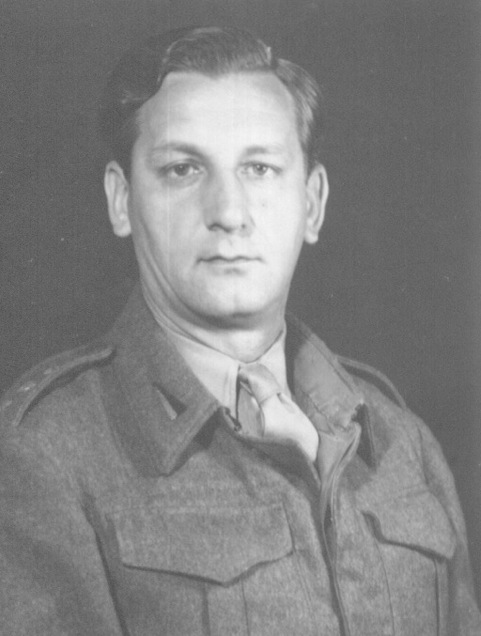
What happened in Dalmatia when Italy surrendered to the Allies?
The second meeting of the Committee for Dalmatia was held on September 8th 1943. By that time it was clear that the Italians would leave, and Split was likely to be taken over by Nazi forces. Therefore members of the Committee negotiated with the Partisans to join forces to resist the invaders, and a formal Agreement was signed with Partisan Commander Lola Ribar in Kaštel Stari on September 12th 1943.
Following this, the volunteer fighters massed in front of Split’s main grammar school (Realna gimnazija) and moved to defence positions between Solin and Klis behind Split. One company, including my father, headed for Kozjak under the command of Colonel Žuvite, behind the Partisan and Yugoslav flags. The collaboration was not without its risks. On reaching Kaštel Stari, the volunteer force was confronted by a Partisan unit and guns were raised on both sides, but after a brief discussion the situation was calmed.
Meanwhile, the Partisan First Proletarian Brigade (Prva proletarska udarna brigada) under Koča Popović (http://sfrj4ever.forumieren.de/t468-prva-proleterska) and the 9th Dalmatian Division arrived in Split, and a second Agreement was signed with the Democrats for the combined defence of Kozjak, this time with all combatants wearing the Partisan Red Star in their caps in place of the emblems of the national army.
The advance of the Nazi Prinz Eugen Division was significantly slowed due to the combined opposition, but their armour and heavy weaponry were far superior to the firepower of the defenders. The defence of Split lasted until September 23rd 1943, when the Partisan Command gave the order to evacuate Split, sabotage the harbour equipment and withdraw to the islands. The defence forces scattered, and there was a large exodus of civilians. Not long afterwards thousands of civilians would be transported on British ships to the refugee camps in El Shatt in the Egyptian desert, but this is another story.
Why was the escape necessary?
In a small town like Split, everyone’s sympathies were known, so first and foremost my father and his colleagues were in danger of arrest by the incoming Nazi forces. My grandfather Prvislav Grisogono had already been imprisoned twice by the Nazis in the early part of the war. Events proved the danger was real: the Nazi forces overran Split during the evening of September 25th 1943, and at midnight two Gestapo officers went to my father’s home to arrest him. (They met their match in our mother, however, who sent them packing in the fluent German which was part of her heritage as a child born under Austro-Hungarian rule.) Meanwhile, my father was safely out at sea, having watched the lights of the tanks and armoured vehicles advancing down from Klis into Split.
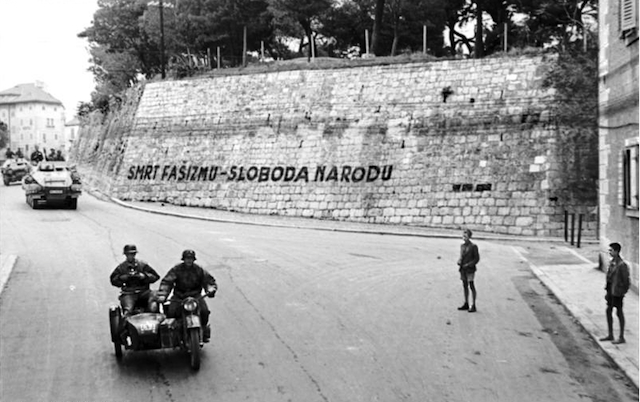
The Nazis were not the only danger to the Democrats. Although they had fought together with the Partisans against the common Nazi enemy, it was well known that they did not support the Communists politically. So they were vulnerable to the summary eliminations which were a tragic part of the internal struggle for political power in Yugoslavia throughout the Second World War.
The third reason for leaving was that it was no longer possible to mount a realistic defence against the Nazis from within the country, whereas joining the British forces in Bari on the other side of the Adriatic offered the opportunity of much stronger action against the enemy, without the complications of Yugoslavia’s internal battles.
How the escape was organized
Mladen Giunio had fought on the defence line near Klis, and was wounded, which gave him the excuse to seek rehabilitation treatment which was available on the island of Šćedro, opposite Zavala on the south side of Hvar Island. He managed to find the bracera which belonged to the Berket family from Kaštela, and was moored at Slatine on Čiovo Island. (The boat’s name was ‘Bog s nami’ - ‘God be with us’. Mladen negotiated for the boat to take them to Italy, and it was agreed that the owner’s uncle and a nephew would travel with them to bring it back.
People on the boat at the start
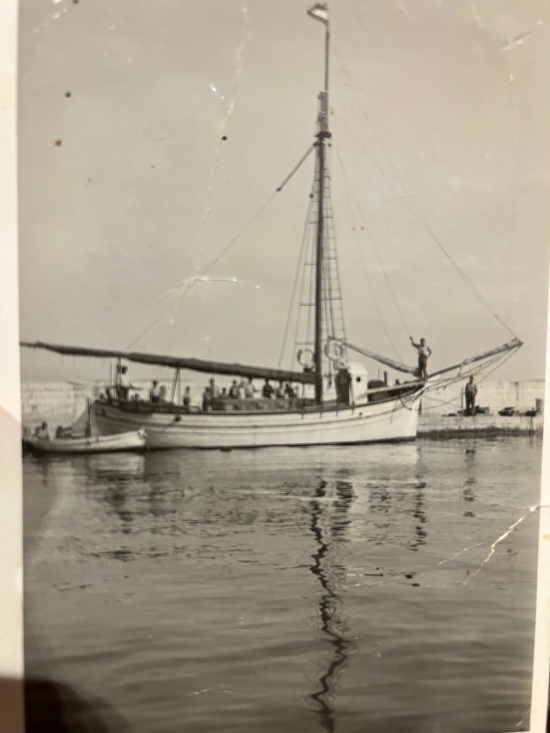
- the 2 members of the Berket family
- a sailor
- Mirko Buić and his son Đorđe
- Dr. Mladen Giunio
- Veljko Duboković
- 2 Lusić brothers
- an Italian officer and his fiancée
- Mr Škrobica and his wife
- Dr Tartaglia (also his daughter, but in the last minute it was decided that the daughter would not travel)
- Vinka(?) Perišin (widow of Major Terence Atherton, who brought with her a bag of food weighing 100 kg)
- Žane (Ivan) and another member of the Plazibat family
- a tradesman from Knin
- Joko Buljan
- Dr. Nenad Grisogono
How the escape unfolded
23.9.1943 On returning to Split from the defence positions, my father went first to Meje (a suburb of Split), then on to Slatine on the island of Čiovo, where he stayed with the don Mjio Dražin, parish priest for Slatine.
25.9.1943. Knowing he was about to leave, my father went to the Tresić villa in Split to say goodbye to our mother Zlata, and then returned to Slatine. At about 6pm, Mladen Giunio arrived with the news that he had found a boat which would take them to Italy, and that they would leave at dusk that evening.
At sunset, my father found and boarded the boat, discovering the Italian officer and his Croatian fiancée hiding under a tarpaulin, to his surprise. The other passengers joined them. The Commander of Čiovo gave permission for the departure after a brief inspection, and they headed off, hugging the coast, in the direction of Split. The sea was calm. After discussion, they decided to head for Maslinica rather than the Split Gates (Splitska Vrata), and filled in the necessary transit forms, which were formally stamped by the younger Berket, by the light of a paraffin lamp below deck. They also checked on the four or five military weapons which they were carrying.
26.9.1943. They passed the Šolta headland at daybreak. My father stayed awake, with the sailor at the helm. As they passed through Maslinica, he instructed the sailor to head out to the open sea to Italy, but the latter refused on the grounds that they might be attacked by enemy planes if they travelled by daylight.
They dropped anchor in a sheltered bay, but suddenly a machine gun opened fire on them from the hill above. The gunner stopped when Mirko Buić and Berket senior shouted at him. My father thought he recognized him as a local man who used to help yachtsmen from the Labud Sailing Club in Split with fishing when they came to Šolta. Now the gunner told them to land and report to the Command Station in Maslinica. There they were asked to register themselves and declare their political allegiances. Personal items which could serve a military purpose were confiscated, but my father managed to keep his gold watch, which was to prove invaluable later.
The sailor told my father that they were expecting another boat from Kaštela, and in due course it appeared, a leut with oars, which belonged to some cousins of the Berkets. Later in the afternoon a trabakul arrived, carrying returnees freed from Italian prisons, who described the horrors they had endured. Then the machine gunner re-appeared in a small rowing boat, and having checked the travellers’ documents, ordered them to move closer to shore, as an Ustaše attack at sea was expected, so it would be safer. Having moved the boat, my father, Mirko Buić and his son went up the hill and lay in the sun. The Šolta harbourmaster in person came to them. He gave them news of the war, and told Mirko Buić and his son that he would send a boat to take them to the Command Centre, and they should bring their things with them, implying that Commander Aračić would receive them kindly. He ordered my father to take the bracera into the Maslinica harbour at sunset, as a convoy would be leaving which would make the passage safer. Then he changed his mind and told Mirko Buić they should come to the harbour in the bracera.
In the harbour there was no sign of a convoy, but the clouds were gathering, indicating an impending storm. At dusk an armed guard was put on the boat, ‘for your safety’. Everyone boarded and they set off along the coast for the south side of Šolta. My father was at the helm, when Joko Buljan came and whispered to him that Mirko Buić and his son were to be put on trial if they went ashore. When told, Mirko refused to believe it, as Commander Aračić was a friend of his. Meanwhile the waves and the wind whipped up, and it started to rain. My father held the boat close to shore, but it was exhausting avoiding the rocks in the dark, and increasingly dangerous, so as they got nearer he decided to put in to Rogač harbour.
Because of the warning about a possible Ustaša attack, my father stayed awake on deck. Which was just as well, because the sailor suddenly raised the alarm at about 11pm, totally without cause. Having put a stop to the false alarm, my father stayed awake to keep an eye on things. The sailor was sipping his drink and suddenly muttered how he didn’t understand, having served in the navy, why he had to kill my father… from which my father concluded that the false alarm had been raised with the intention of creating confusion as a cover for killing him and others off.
27.9.1943. They reached Rogač in the early morning, at about 3am. My father wanted to sleep, but Mirko Buić persuaded him that they should visit a friend, Dr. Mladinov, whose house was on the shore a short distance from the harbour. The rain had stopped and the wind had dropped slightly, so they went. Dr. Mladinov was obviously disconcerted to see them, but invited them inside, where they found the Šolta Commander sitting with a young Partisan woman of about 20 - 25. They exchanged pleasantries while Dr. Mladinov went to get some prošek, but when Mirko Buić tried to offer the toast, the Commander got up to leave, telling Dr. Mladinov that they would continue their meeting later. As he left, the Commander ordered my father to bring the bracera to Stomorska at first light. Mirko, trying to engage him in conversation again, invited the Commander to join them on the boat, but he said he would go on his motorbike. Knowing that such night-time meetings among the Communists were usually preparations for summary trials followed by executions, my father was sure that they were being summoned to Stomarska to be put on trial.
However, they had no choice but to move on to Stomarska, arriving at about 9 or 10 am under overcast skies. As soon as they arrived, they were sequestered in the local school. The armed guard at the door was a local Šolta man by the nickname of Ćuvita. He had previously been caretaker at the Labud Sailing Club in Split, but was sacked for stealing. After about half an hour a Partisan patrol of two soldiers arrived and asked Ćuvita if there were any weapons in the warehouse. Cuvita replied in the negative, but suggested that they should return in a couple of hours, when there might be something. After some time the guard disappeared, and my father went outside, passing unhindered along the waterfront to the west side of the harbour where the main administrative buildings were. There he found Mladen Giunio and some other acquaintances.
Mladen reassured my father, saying he was working on getting the permit to go to Šćedro for his rehabilitation treatment. Hours went by, then Mladen reappeared with his permit, but also the news that they had to take on about 20 refugees who were being transferred to Hvar. By this time it was about 2pm.
My father ordered the refugees to go below deck, otherwise the deck would obviously be overloaded. There was quite a strong Maestral wind blowing, and they crossed the Brač Channel (Brački kanal) under sail to reach the Split Gates (Splitska vrata). Mladen gave the coded signals and they passed through. The sea was rough, and the group below deck began to protest, but they were not allowed to come out. At sunset the boat arrived at the Hvar headland. As they came close to land, Mladen recognized some friends among a group of about 30 armed Partisans.
With strong headwinds and the boat full, progress was impossible even with engine power, therefore, probably at Mladen’s suggestion, they headed for Sokolica bay (also known as Ložišća, today’s Vira) on the north side of Hvar. It was beautiful sailing under the setting sun into the deep bay to the sheltered harbour inside. They spent the night there. That night or the following day Mladen Giunio and Žane Plazibet set off for Hvar Town.
28.9.1943. The refugees were sent on their way towards Hvar on foot, while my father and the others waited for Mladen and Žane, perhaps for the whole day. Mirko Buić and his son went and swam in the bay, where they heard some fishermen describing how a patrol boat had arrived looking for their bracera, but had left when they heard that a boat (actually another boat which had arrived afterwards) had been in the bay and departed, heading for Hvar.
29.9.1943. As there was no sign or word from Mladen and Žane the following morning, my father decided to go to Hvar to see what the situation was there, leaving Mirko Buić looking after the boat. As he passed the Fortress, the guards asked who he was and where he had come from. When he answered that he had arrived on a bracera and was going to Hvar, they waved him on. He met Žane by chance as he entered Hvar Town. Žane turned pale on seeing my father, and asked “Are you mad? They’ll kill you, go back straight away!” My father agreed to go back once Žane had told him what was happening to Mladen and what the situation was. The reply was that Mladen was waiting for the permit to proceed and everything would be all right, but my father had to go back and wait on the boat. So he went back, past the watch on the Fortress, and told Mirko Buić what had happened.
Mladen returned either that evening or possibly the following one. They left Sokolica immediately, as he instructed, heading for Hvar under engine power.
29.9 or 30.9.1943. They moored on the west side of Hvar harbour for about half an hour, although my father could not remember why. He thought Mladen probably had to complete the final formalities of their permit to proceed to Šćedro. My father was warned not to be seen on the waterfront, so he possibly hid below deck. He seemed to remember that a friend, Sava Bošković, came to the quay to greet them.
When night fell, they headed off, ostensibly towards Šćedro. Mladen advised that they were certainly being watched, so they should look as though they were going in that direction before heading for the open sea. So my father steered towards the east for a while, then went below deck to check the coordinates for Palagruža on the map. Using his hand compass, he turned towards the south-west, aiming to arrive to the west of Sv. Andrija (St. Andrew’s) island.He calculated that they should be in the vicinity of Palagruža at around 4 am.
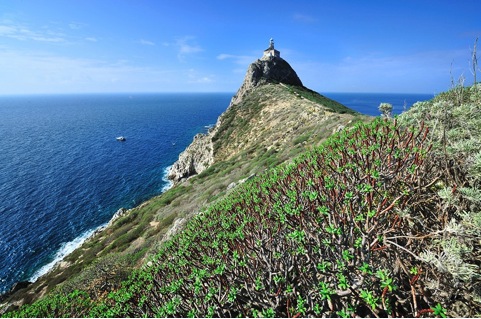
30.9 or 1.10.1943. As they neared Sv. Andrija, my father heard the sound of an engine, but it did not come nearer, so they continued sailing unhindered in the middle of the Adriatic. At 4 am it was still dark. My father stopped the engine, reckoning that they should be at their destination. Indeed, at daybreak the outline of a craggy island began to make an appearance to their right. Palagruža.
They set off towards the west, passing the eastern headland of the island, and came to the open beach towards the middle of the island which was the only place where one could reach the shore. They all disembarked on to the beach. My father found a beached boat and stretched out on it to rest. Mladen and some of the others went off to find the Italian garrison. They found a lieutenant on guard in a cave with a gun by his bed - he told them that the gun was at the ready to kill his fascist commanding officer. A Chianti bottle hung from the ceiling by a rope. An impromptu target contest was organized to see who could shoot the Chianti bottle most accurately. The boat people won. Then the Commander, with twelve men under his leadership, offered to surrender to the incoming Yugoslav Army, so Mladen accepted and took over control of the island! Oddly enough, one of the first decisions of the Paris Peace Conference after the war was to give Palagruža to Yugoslavia.
At around 1 pm my father met the Commander and asked for news, but he only knew from the radio that Italy had capitulated, nothing further, and could not answer the more pressing questions of how far the Allies had advanced in Italy, and where were the Germans?
The Commander warned that a storm was forecast, and there was no secure shelter for a boat on the island’s shores. He gave them a barrel of 100 litres of fuel from a boat which had sunk. There was a heated discussion, as Mirko Buić was afraid that they could fall into the hands of the Germans, but it was obvious that they could not stay where they were. My father insisted that they should set off straight away for mainland Italy, which was clearly delineated on the horizon by the heights of Monte Gargano, and find whatever suitable landing place they could.
They set off, and came upon some fishermen outside the harbour of Vieste. My father called to them, asking who was in charge there? and they answered “Nessuno”. The Germans had left two weeks previously, and another military presence had come in and then gone north. So they arrived safely in Vieste, and a spontaneous cheer was raised as they entered the harbour. They all hugged each other in relief and happiness, then went ashore to find something to eat. My father found a restaurant and had his first solid meal of the trip at about 5 or 6 pm.
1.10 or 2.10 1943. My father could not remember if they slept over in Vieste, or set off immediately to the south to find the English forces in Manfredonia. When they arrived there they found three English warships in the harbour. Some English soldiers boarded their boat and searched below deck, but were generally friendly. They found it difficult to believe that this boat had come from the other side of the Adriatic. They were commandoes and were obviously afraid or suspicious of possible spies. Their sergeant gave the boat people a box of army rations, including dry biscuits, corned beef and cigarettes, as well as an English flag. They positioned the bracera in between their boats on the quay, but later disappeared into the night, heading north to sabotage the German forces in retreat.
2.10.or 3.10.1943. After a night’s sleep in the harbour at Manfredonia, the bracera set off southwards to Bari, with the English flag raised. However, before they got to the harbour, a three-masted yacht running on engine power came towards them and opened fire.
Nonetheless, the bracera made it into the safety of the harbour, and the travellers said their goodbyes and prepared to go their separate ways. The two Berkets told my father that they were going back to Kaštela, while Mirko Buić (and presumably his son also) went to Molfetta. My father was not sure, but thought the Lusić brothers and Veljko Duboković joined the British forces in Foggia. He himself slept in a hotel in Bari for the night, and then joined the British forces at Campo Carbonara 75 under Commander Venables, where he was given the rank of Captain.
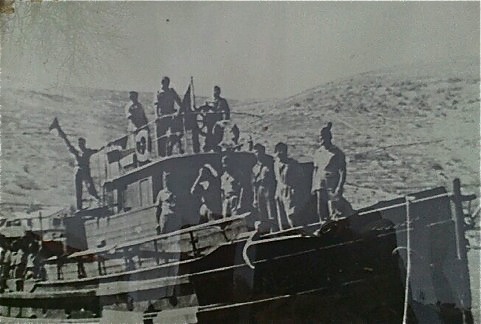
Postscript. The conclusion of this journey marked the end of a chapter in the lives of the participants and those they left behind, and the start of a new chapter, which in most cases involved considerable hardship and a struggle for survival.
I was not born at the time, and it is only since I have become familiar with the Adriatic and its islands much later on in my life that I can appreciate just how hazardous the journey was in itself, even without the added perils of the numerous potential enemies who created an obstacle course for the boat people who were trying to flee to freedom.
The history of former Yugoslavia is complicated in many ways. Knowledgeable people most often have entrenched opinions and bias based on their background, viewpoint and personal experience. It’s relatively easy to tell the story of the victors in a war, also that of any extremists who opposed those victors. The story of those who belonged ‘in the middle’, who belonged to no obvious factions, and who ultimately lost everything they held dear, including their ideals of living in a free, democratic and just society in their own country, is seldom told.
The tale of this escape from war-torn Yugoslavia during the Second World War is just one of the many untold stories of individuals who fled one situation to try to find a new and better one in which to operate. Out of the frying pan into the fire? Yes, in some cases.
My father Nenad was a lifelong optimist with an everlasting sense of humour. I remember him telling the tale of his escape for my amusement when I was very young, dwelling on the farcical situations which arose, such as the shooting match on Palagruža, and coming across the pre-dawn Committee Meeting discussing the life-or-death destiny of himself and his friends. It was a wonderful bedtime story. He never mentioned the tiredness, stress, hunger and fear which certainly accompanied the events and dogged all the participants in the drama.
His sense of humour and optimism sustained him through the trials of fifty years of exile in the UK, a country whose customs, language and climate were always foreign to him. It is a pity he did not live long enough to learn that there was a sequel to the surrender of Palagruža to his friend Mladen Giunio, something I only learned by chance in 2012. Apparently, when the Communist authorities realized the bracera had taken an escape route to Italy, a Partisan boat was sent in pursuit (pictured above).
They arrived at Palagruža after the bracera had left, and the Italian Commander took the opportunity to surrender the island yet again. Mladen Giunio was born in 1914 in Kotor, which was part of Dalmatia within the Austro-Hungarian Empire at the time. He was Croatian and lived mainly in Split as a youth, and he had strong ties with Hvar Island. The Partisan officers on the pursuit boat were all from Hvar. This meant one could say that Palagruža was handed over first to Split / Hvar and then to Hvar in quick succession, whereas after the war it was put under the control of Vis, which has been a bone of (mainly friendly) contention between Vis and Hvar ever since. My father would have been highly amused by these twists and turns.
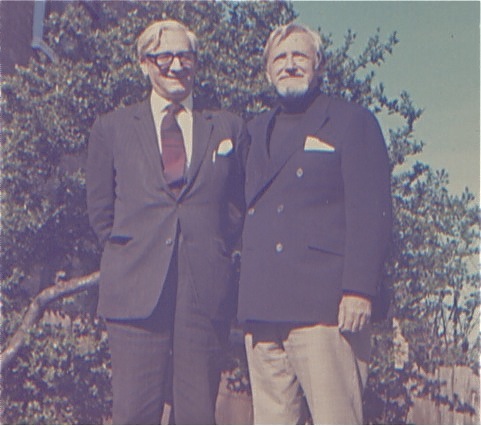
© Vivian Grisogono 2014, 2025.
I am extremely grateful to historian Mijo Ostojić for contacting Captain Josip Berket (in 2025) who then kindly took the trouble to find the photographs of the bracera in his archives.
References: Notes prepared by Nenad Grisogono 1973 Details of the journey were verified by Mladen Giunio Zorkin in the same year.
Croatia Through History, by Branka Magaš, Saqi Books, London, 2007. ISBN xzd978-0-86356-775-9
Palagruža, Diomedov otok, by Branko Kirigin,pub. Književni krug, Split 2012, is an excellent all-encompassing account in Croatian of the islands which make up Palagruža.



